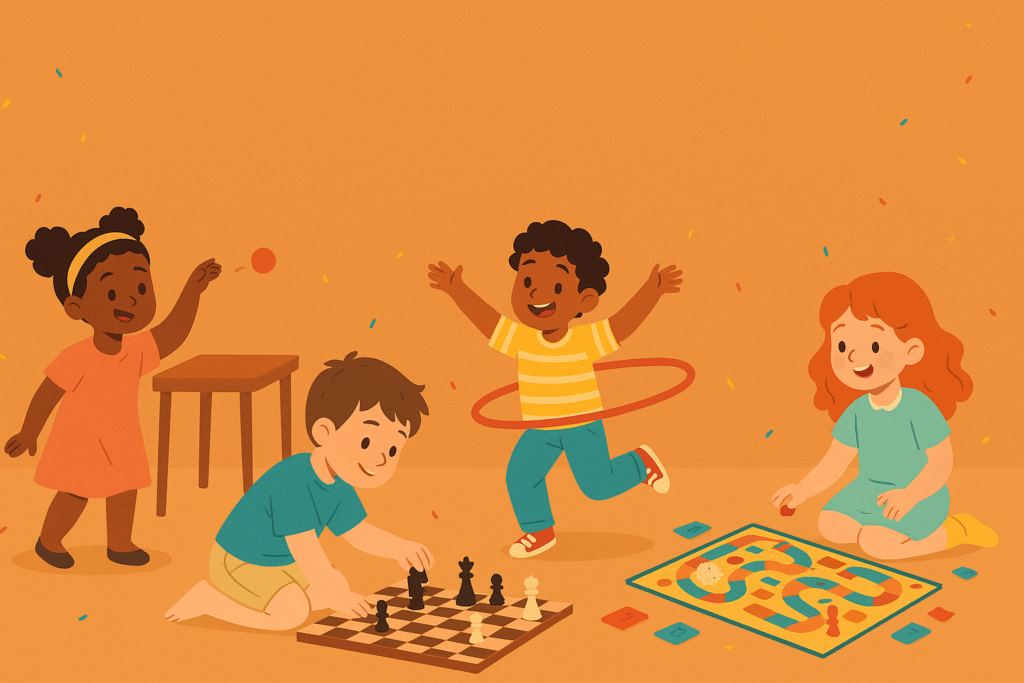Rain tapping against the windows, the sun blazing too hot to step outside, or just a cozy afternoon at home—these moments are perfect for indoor fun. Indoor games aren’t just a way to pass time; they ignite creativity, teamwork, problem-solving, and pure joy. With the right activities, your living room can transform into a race track, stage, or even a treasure island.
Whether you’re a parent, teacher, or simply someone who loves engaging with kids, this list of top 15 indoor games will keep young minds active and happy—no screens required.
1. Treasure Hunt
Hide small items around the room and create clues or a treasure map. For younger kids, use picture clues. For older ones, add riddles or puzzles they must solve to find the next clue. This game encourages problem-solving and teamwork, making it a favorite in homes and best CBSE schools in Bangalore.
2. Musical Chairs
Arrange chairs in a circle, play upbeat music, and have kids walk around. When the music stops, they scramble for a seat—removing one chair each round. Great for listening skills, agility, and quick decision-making. Pro tip: occasionally reverse the walking direction to keep it exciting.
3. Indoor Bowling
Use empty bottles as pins and a soft ball. Keep score like real bowling, and even create a “league” if you have enough players. Kids love the competitive spirit, and it helps improve hand-eye coordination.
4. Balloon Volleyball
Replace a volleyball with a balloon and a ribbon for the net. The light balloon keeps play safe indoors while improving reflexes. You can add variations like “don’t use your hands” to make it sillier.
5. Freeze Dance
Blast some music and let everyone dance. When the music stops, they must freeze in place. Add twists like “freeze in an animal pose” or “freeze with one leg up” for more fun. This is a great energy burner, perfect for indoor PE breaks.
6. Board Game Marathon
Board games like Snakes and Ladders, Scrabble, and Ludo teach patience, strategy, and math skills. Make it a tournament with small prizes for winners.
7. Simon Says
One person gives commands starting with “Simon says…”—but if they don’t say “Simon says” first, and a player still follows, they’re out. This game is perfect for building listening skills and quick thinking.
8. Carrom
A traditional game that teaches patience and precision. It’s a wonderful way to connect generations, as grandparents often enjoy playing too.
9. Indoor Obstacle Course
Use pillows to jump over, chairs to crawl under, and tape to mark “balance beams.” This game boosts agility, coordination, and imagination. For safety, ensure the space is clear of sharp objects.
10. Story Building Game
Sit in a circle, and one player starts a story with one sentence. Each person adds their own twist. This boosts creativity and helps children think on their feet. For more excitement, set a timer so each player only has 5 seconds to add their sentence.
11. Pictionary
A game of drawing and guessing that sparks imagination. No artistic skills needed—the funniest drawings often make the best memories!
12. Sock Basketball
Roll up socks and aim for a laundry basket. Add levels of difficulty by increasing the distance. This game improves aim and focus, and it’s completely safe for small spaces.
13. Memory Tray Game
Place 10–15 items on a tray. Give kids 30 seconds to observe, then cover the tray and ask them to list as many as they remember. This game strengthens memory and concentration.
14. Indoor Scavenger Hunt
Give kids a list of household objects to find—like a spoon, red sock, or blue pen. For an educational twist, ask for objects that start with a certain letter or match a color.
15. Puppet Show
Use hand puppets or make your own with socks and craft supplies. Kids can create characters, write scripts, and perform. This builds confidence, creativity, and storytelling skills.
Why Indoor Games Matter
Indoor play improves creativity, problem-solving, motor skills, and social interaction. Many nursery schools in Bangalore design daily schedules with a mix of indoor and outdoor games to balance learning and fun.
Traditional Indian Indoor Games
Introduce kids to cultural favorites like Pallanguzhi, Chowka Bara, and Snakes and Ladders. These games have been enjoyed for generations and often have educational value—like counting, planning, and strategic thinking.
Balancing Indoor and Outdoor Play
While indoor games are fantastic, children also need fresh air and open spaces. Explore the benefits of outdoor play to understand how both work hand-in-hand for healthy growth.
The Role of Physical Education
Schools that focus on physical education often integrate indoor games into PE sessions. They provide active, engaging ways to keep kids moving, even when weather or space is limited.
Tips for Hosting Indoor Game Sessions
- Safety first: Clear sharp objects and fragile items from the play area.
- Mix activities: Alternate high-energy games with calm ones.
- Let kids lead: This builds leadership skills and confidence.
- Add themes: A pirate treasure hunt or superhero obstacle course makes games even more exciting.
Final Thoughts
Indoor games aren’t just for rainy days—they’re essential for a child’s development and happiness. From boosting creativity to building teamwork, the right games can turn any room into a playground of imagination.
So the next time boredom knocks, you’ll have 15 exciting indoor adventures ready to go.
FAQs
1. Why are indoor games important for children?
They boost creativity, problem-solving, teamwork, and motor skills.
2. What are some simple indoor games for small spaces?
Sock Basketball, Memory Tray, Pictionary, and Story Building.
3. Can indoor games be educational as well as fun?
Yes, games like board games and treasure hunts teach skills while entertaining.
4. How can parents balance indoor and outdoor play?
Mix both—indoor for creativity and focus, outdoor for fitness and social skills.
5. What are some traditional Indian indoor games kids can try?
Carrom, Pallanguzhi, Chowka Bara, and Snakes and Ladders.

